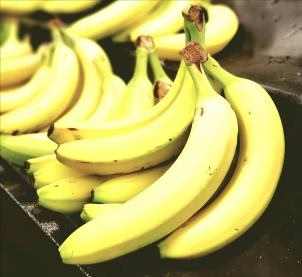There are many questions about bananas. Some say that bananas with black spots should be avoided, and some say that green bananas at the head and tail have been ripened with potentially carcinogenic ripening agents. Are these rumors true?
Bananas with black spots have higher nutritional value.
There’s also a rumor that “black spots on bananas mean they’re overripe and should be avoided.”
When choosing bananas, if black spots appear on the skin, it doesn’t mean the banana is rotten; rather, it indicates the banana is at its sweetest. However, if you’re still concerned, rinse it with water before eating. It’s not recommended to eat the entire banana until it’s completely black and ripe.
The Banana Ripening Process
Bananas ripen in different stages. First, green bananas turn yellow. Green bananas are refrigerated at 16-18 degrees Celsius for 5-7 days to ripen, then they turn yellow. When yellow bananas develop black spots, they are at their most nutritious. They are rich in sodium, serotonin, protein, potassium, phosphorus, calcium, and other nutrients, making it a waste to throw them away.
To determine the ripeness of bananas, you can smell, look, and touch them. If a banana has a distinctly sour smell, the skin has completely turned black, or it’s soft to the touch, it’s not suitable for consumption.
Why do the skins of bananas and mangoes turn black?
If the skin of a fruit turns black, many people worry that it’s of poor quality or about to go bad.
However, fruits like bananas and mangoes with black spots or black spots actually have higher nutritional value. This is because they are rich in polyphenol oxidase and phenols. Over time, this reaction produces a black substance, but it also makes them taste sweeter.
This is especially true if the skin is damaged or if they’ve been impacted during transportation. Polyphenol oxidase and phenols react, and with the help of oxygen, they produce the black substance.
This process doesn’t produce any harmful substances. If only the skin appears black, it doesn’t affect the quality of the flesh and can still be eaten safely. However, if the flesh turns black, it’s not recommended for consumption.
We also remind everyone that mango peels contain histamine, an allergen that can easily trigger skin allergies and other symptoms. People with sensitive skin should be cautious.
Do bananas with green heads and tails have been treated with ripening agents? Is this harmful to the human body?
There’s a rumor circulating online that “bananas that are green at the head and tail and yellow elsewhere are treated with ripening agents, which can cause cancer.” Bananas ripen naturally. Commercially available bananas are harvested before the green-ripe stage and then subjected to low-temperature ripening to accelerate ripening. This is not due to the addition of ripening agents.
If bananas are left to ripen naturally on the tree, they often fail to change color and ripen uniformly, resulting in poor taste and quality. Therefore, most commercially available bananas are harvested before the green-ripe stage and then subjected to low-temperature ripening to achieve consistent ripening quality.
Green bananas are ripened at low temperatures (14-20°C) for approximately 5-7 days. On the first day, alcohol or calcium carbide (calcined clay) is used to produce trace amounts of ethylene. Ethylene is a volatile substance that naturally evaporates and dissipates, refusing to remain in the banana and posing no carcinogenic risk.
This causes the green banana skin to gradually turn from green to yellow. No ripening agents are applied. The “green bananas at the head and tail” rumor circulating online are actually bananas with a peel that has reached the fifth color change level. There’s no need to worry; they are safe to eat.


Leave a Reply